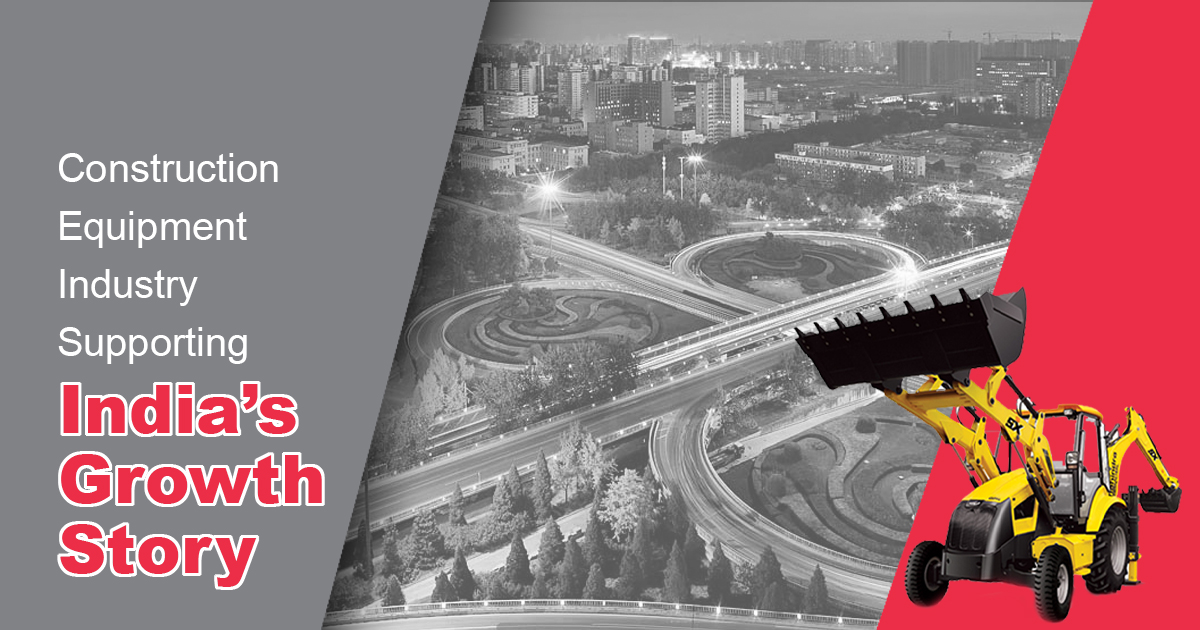Construction Equipment Industry Supporting India’s Growth Story

Currently, India is fast progressing towards becoming the manufacturing centre for the globe. For the first time ever, it is eyeing to compete with China on the manufacturing and infrastructure front. In lieu of this, the investments on infrastructure building have increased considerably in the country in past few years and are expected to continue to rise in the future as well. It is believed that the country would require about $7 trillion infrastructure investment over the next seven years and for that the government has already started taking proactive steps.
Further, India is continuously pushing for the development of well-developed road network and highways in the country. In fact, the budgetary allocation for National Highway Authority of India (NHAI) has increased considerably in the recent years. Also, the government is aiming to develop the Golden Quadrilateral connecting four major metropolitan cities viz. Delhi-Mumbai- Chennai-Kolkata. Construction of North South and East West Corridors (NS-EW) connecting Srinagar to Kanyakumari and Silchar to Porbandar with a spur from Salem to Cochin is also on cards of the government. Government is also aiming at six laning of existing four-lane highways.
In addition, due to the government’s impetus and focus given to the ‘Make in India’ initiative, the manufacturing sector in the country is also growing at as fast pace. Further, the real estate market in India is expected to reach $ 180 billion by 2020. All these initiatives and developments are having a very positive effect on the Construction Equipment (CE) segment of the country which greatly impacts various other sectors of the economy.
It is believed that the CE market in India has the potential to grow to $5 billion by 2020 on the back of infrastructure and manufacturing growth. Here, it would not be wrong to say that the CE sector growth, if properly stimulated by the government and honestly pursued by all the manufacturers can surely generate positivity across not just Indian but the global economy as well.
Tracing the journey of CE segment
Until 1960s, domestic requirement of CE was entirely met by imports. However, change came about in 1964 when domestic production of CE began with the setting up of Bharat Earth Movers Ltd (BEML), a public sector unit of the Ministry of Defence, at Kolar in South India. This was set up to manufacture dozers, dumpers, graders, scrapers, etc., for defence requirements under licence from LeTorneau Westinghouse, USA and Komatsu, Japan. Gradually, private players joined the bandwagon.
One of the most notable entrants in the CE segment in the country is the Mahindra Construction Equipment (MCE), a part of US $19 billion Mahindra Group. It started its business in the CE segment in India in 2011 with its revolutionary backhoe loader—Mahindra EarthMaster which is loaded with technology not hitherto seen in this product segment in India. Then in 2017, MCE entered into the fast-growing road CE segment with the launch of motor grader—the Mahindra RoadMaster G75 which is made in India for the Indian roads.
With decades of innovation by indigenous players as well as the entry of multinational corporations, today, India has become self-sufficient in the CE segment and has even started exporting CE to other countries. In fact, the Indian CE industry has traversed a long way since its initial days and has seen huge investments made by national as well as international companies for setting up their manufacturing bases in the country. Here, it is worth mentioning that India has a great advantage over the foreign countries as the equipment manufactured in the country are not only cost-effective but also better in reach and support as compared to the neighbouring countries.
Overall, with a wide production capacity base, India has become perhaps the only developing country in the world which is totally self-reliant in manufacturing some of the highly sophisticated CE.
CE supporting India’s growth story
In the recent past, many ambitious projects have been announced by the Indian government and for all those projects, the eyes are on the CE segment which can help in completing these projects. These projects include highway development program, Smart Cities Mission, Bharatmala Pariyojana, Sagarmala Programme for modernisation of ports, increasing connectivity and port linked industrial hubs, airport development and upgradation program, Jal Marg Vikas, Atal Mission for Rejuvenation and Urban Transformation (AMRUT), Housing for All and Diamond Quadrilateral for high-speed railways, river linkages and bullet trains. Even the rural infrastructure development has picked up the pace in the country.
Thus, time has come when the CE industry has to think more proactively followed by sure-short actions to meet the growing demand of the future as the country marches ahead to become a global leader by 2020. The Construction Equipment manufacturers need to come up with innovative solutions like remote access devices, automatic controls to manoeuvre machines, more efficient (Tier III) engines, cabin air-conditioning etc. The CE manufacturers need to make equipment which are in compliance with the new as well as the future norms. Well, here MCE’s contribution should be surely noted. Its Mahindra EarthMaster backhoe loaders
In a nutshell
Rapid urbanisation and growth in infrastructure as well as manufacturing sector would definitely fuel the demand from the Indian Construction Equipment manufacturing industry over the coming years. And it would not be wrong to say that the CE industry would be hugely responsible for supporting the India’s growth story.









